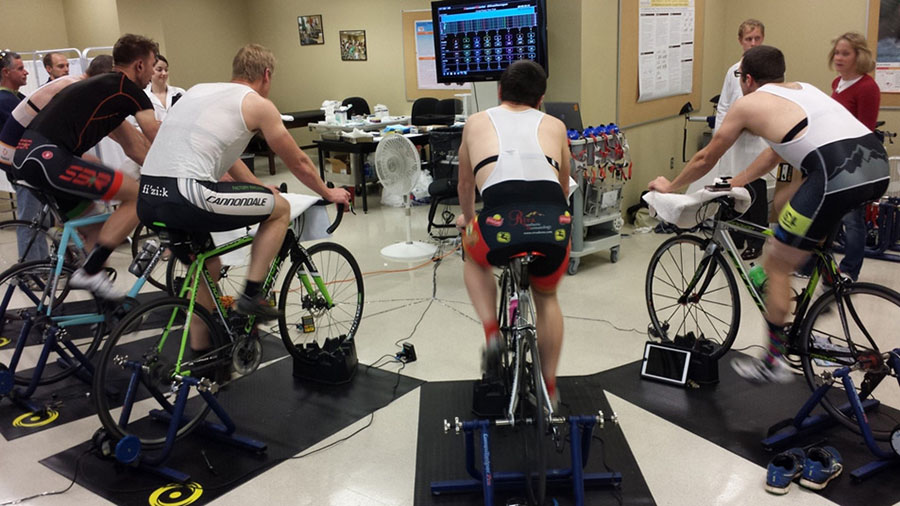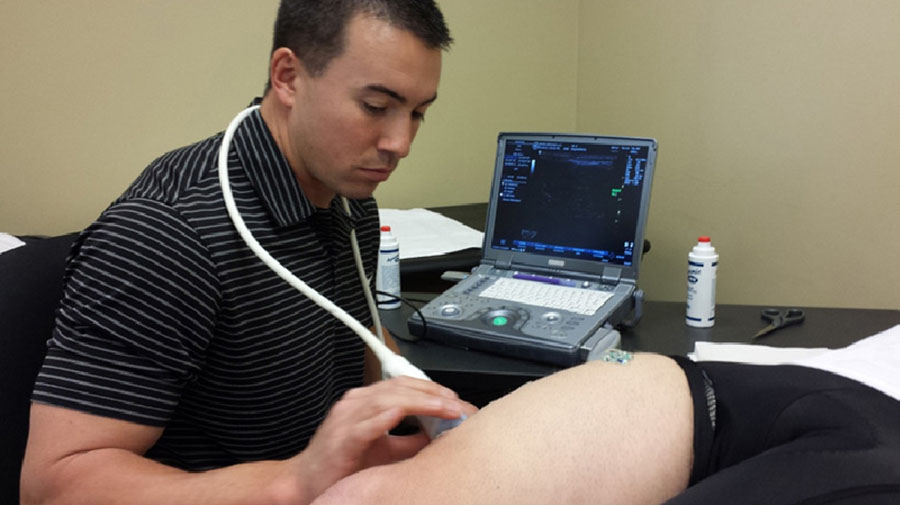
To determine the effectiveness of the MuscleSound® system, 20 cyclists allowed ultrasound scans and muscle biopsies of their vastus lateralis muscle, which is part of the thigh, before and after completing a 75 km ride at Appalachian State University’s Human Performance Laboratory at the NC Research Campus (NCRC) in Kannapolis. (Photo submitted)
Kannapolis—Researchers in exercise and sports science can put away their biopsy needles. The Appalachian State University Human Performance Laboratory at the NC Research Campus (NCRC) in Kannapolis has validated the use of ultrasound technology to measure muscle glycogen.
Muscle biopsies have been the standard method of measuring muscle glycogen. They involve inserting a needle into a muscle, usually in the leg, to remove a piece of muscle for laboratory testing. The procedure can take up to half an hour, requires a doctor, local anesthesia, stitches, and aftercare that can interfere with training.
Since an athlete’s glycogen level directly impacts their performance, measurement is vital.
“When you train intensely, the primary fuel is the glycogen in the muscle and when that is low you cannot push intensely,” said David Nieman DrPH, FACSM, director of the Human Performance Laboratory and professor of health and exercise science in Appalachian’s College of Health Sciences. “The NCRC is all about industry and university research, and this is a great example.”

A technician uses a non-invasive MuscleSound® ultra sound devise to measure muscle glycogen pre and post exercise. Researchers at Appalachian State University’s Human Performance Laboratory at the NC Research Campus (NCRC) in Kannapolis found the MuscleSound® data were as accurate as information from a muscle biopsy. (Photo submitted)
Ultrasound is commonly used in exercise and sport science for real-time visualization of movement and to measure hydration and body fat. MuscleSound® of Denver, Colorado, offers a non-invasive portable, diagnostic high-frequency ultrasound and cloud-based software that works by scoring the difference in pixel intensity as the scans transition from darker to lighter reflecting glycogen use.
Study design and results
To determine the effectiveness of the MuscleSound® system, 20 cyclists allowed ultrasound scans and muscle biopsies of their vastus lateralis muscle, which is part of the thigh, before and after completing a 75 km ride using CompuTrainer Pro Model 8001. On average, the cyclists experienced a 77 percent decrease in their total glycogen content. Pre-exercise testing also showed whether the athletes had high or low glycogen levels to begin with.
When the ultrasound scans and the analysis of the muscle biopsies were compared, the results correlated closely when measuring both the overall decrease in glycogen and starting and ending glycogen levels. The study “Ultrasonic assessment of exercise-induced change in skeletal muscle glycogen content” was published in the journal BMC Sports Science, Medicine and Rehabilitation in April.
“We couldn’t believe how tight the correlation was,” Nieman said. “We’re excited about the results because what this does for researchers around the world is that now, without taking a biopsy, they can very precisely measure if athletes are low or high in glycogen.”
Applications
The technology is useful for researchers and athletic trainers. “Glycogen has to be supported through a high carbohydrate diet,” Nieman said. “The tendency in some athletes is to eat a lot of meat and dairy products and to avoid foods like fruits, pastas and rice. The high protein diet is not the friend of a high performing athlete. It just won’t get them where they need to be.”
With this technology, trainers can help athletes enhance their performance through a diet designed to keep their muscle glycogen optimized.
By reducing the need for muscle biopsies, Nieman expects to see more research on muscle groups like the deltoids in the shoulder that have not been studied as intensely as leg muscles. He is already using MuscleSound® He is already using MuscleSound® to provide diet counseling to runners at UNC Charlotte, and is planning a study in partnership with Amy Knab, PhD, professor of exercise and sports science at Queens University of Charlotte, using the system with elite swimmers.
“This is really an honor for us. MuscleSound® looked at all of the labs that could do this testing for them, and they came to us here at the NCRC,” Nieman said. “The NCRC is all about industry and university research, and this is a great example.”
“Our participation in this study is a positive step forward in the complete understanding and optimization of glycogen within the human body,” added Stephen Kurtz, CEO of MuscleSound. “We are proud to be leaders in helping prevent injuries, improve performance and enhance nutrition. Working with Appalachian, Dr. Nieman and his colleagues was an outstanding experience.”
About Appalachian State University
As a premier public institution, Appalachian State University prepares students to lead purposeful lives. App State is one of 17 campuses in the University of North Carolina System, with a national reputation for innovative teaching and opening access to a high-quality, cost-effective education. The university enrolls more than 21,000 students, has a low student-to-faculty ratio and offers more than 150 undergraduate and 80 graduate majors at its Boone and Hickory campuses and through App State Online. Learn more at https://www.appstate.edu.
What do you think?
Share your feedback on this story.











